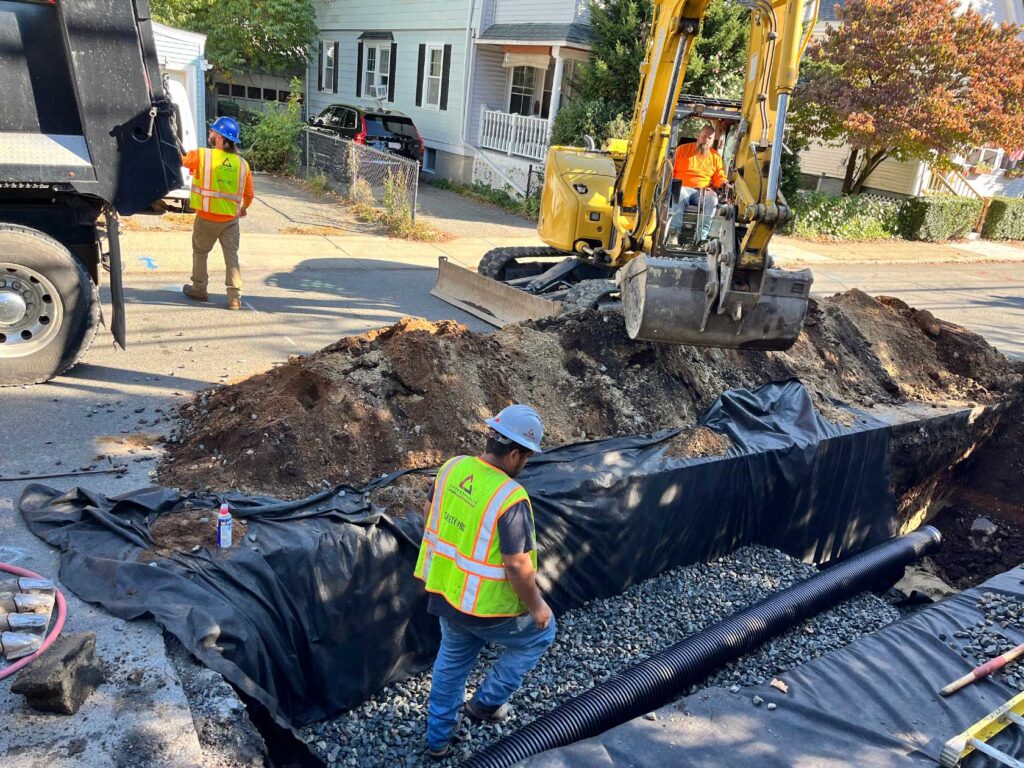Algae clogging up your river?
Mystic River Watershed Association says try an infiltration trench

When rain hits the asphalt, surface chemicals and pollutants rush straight to the nearest body of water. But a state grant is funding an effort to reduce that contamination in six municipalities across the metro Boston area.
Tapping into nearly $870,000 through a grant from the Massachusetts Department of Environmental Protection, the Mystic River Watershed Association will install 65 infiltration trenches over the next two years. The trenches function as nature-based infrastructure, removing pollutants and contaminants from rain or melting snow as it flows through storm drains and toward rivers and other waterways.
“When you pave over — like we have in our very urbanized watershed in the Mystic — you lose that connection with the soil,” said Marja Copeland, stormwater projects manager at the Mystic River Watershed Association. “So, storm water that’s hitting the ground is no longer doing that soak through; it’s running straight down into the catch basin.”
Pollutants like phosphorus usually filter directly into the soil, but in an urbanized area, surfaces like roofs, asphalt and concrete — referred to as impermeable surfaces because they don’t absorb water — collect those pollutants instead. When a storm comes, the precipitation flushes the pollutants across the impermeable surfaces and into the catch basins of storm drains.
Once in the catch basin, it doesn’t go through any cleaning process. Instead, it’s carried straight to a waterway. Infiltration trenches add an additional step to change that.
“If we don’t put these in, the existing pipes are just transmission pipes, they’re just distributing the water from the street to the water. What these do is they intercept it, and they treat it,” said Wayne Chouinard, town engineer in Belmont and one of the original designers of the infiltration trenches.
The technology behind the infiltration trenches is relatively simple, but understanding its design requires an understanding of a normal storm drain. There, water falls through a grate in the street and fills an underground catch basin until the water level is high enough that it goes through a pipe out to a nearby waterway.
Infiltration trenches are dug as an extension of those existing drains. Stormwater, with all the pollution that the runoff carries, flows into the storm drain but a lower pipe carries water out first, before it can flow to a waterway. The first wave of polluted water goes into this lower pipe where crushed rock and the soil naturally filters out pollutants like phosphorus. If the water level continues to rise, by the time it reaches the pipe that flows out to a body of water, much of the pollution will have filtered out.
This type of design is considered green infrastructure, a broad umbrella term which describes solutions that use natural processes to solve problems. Green infrastructure is used in contrast to — or sometimes in conjunction with — gray infrastructure, which includes gutters, drains, pipes and retention basins.
Anna Yie, green infrastructure specialist at the Neponset River Watershed Association, said that green infrastructure solutions to stormwater challenges can be “incredibly effective” in addressing nuisance flooding, especially as a changing climate leads to more intense storms.
“Even in the past couple of years, when we have those torrential sorts of downpours, that much water that fast is really stressing the capacities of our systems,” Yie said. “Green infrastructure can play a very important role in helping to mitigate that.”
In the Mystic River watershed, the trenches are being hailed as a solution particularly for removing phosphorus from the river and its various tributaries.
The watershed has an “alternative Total Maximum Daily Load,” a state-established plan under the federal Clean Water Act to restore waterways by identifying the maximum amount of a pollutant that can enter the water while still meeting water quality standards.
Excess phosphorus in a waterway can impact local plant and animal life. A natural nutrient needed by plants to grow, too much can spur the growth of invasive species that can outcompete local flora.
And as those plants grow and die, they take up oxygen in the water that local animals need to survive.
Too much phosphorus can also lead to the growth of cyanobacteria, algal blooms that spread over the water and can be harmful to humans and toxic to animals.
“When you have higher loads of phosphorus going into the waterways, you get essentially an encouragement of all the plant life growing within the waterway,” Copeland said. “They do need phosphorus to grow — it’s not a bad thing — the problem is the excess of it.”
Those effects mean scientists call phosphorus a “limiting nutrient,” for its ability to determine how much or little plant life can grow. Infrastructure, like the infiltration trenches, that can reduce excess amounts of those nutrients entering the water is key, said William Shuster, a professor of civil and environmental engineering at Wayne State University in Detroit, Michigan.
“Anything we can do to prevent the movement of these limiting nutrients into our waterways is very important,” he said.
Across the state, Yie said, excess phosphorus is an issue in bodies of water, even if not every watershed has a Total Maximum Daily Load. For example, the Neponset River watershed has no TMDL, but its watershed association keeps an eye on the chemical in its waterways and does work to remediate..
The trenches are most effective at removing pollutants from the “first flush” of stormwater, the initial wash of runoff that flows over streets, roofs, and other impervious surfaces, taking with it the pollutants that had built up since the last storm.
As more water flows into the system, any contaminants it carries may go straight to the waterway, but generally it’s that first flush, which Copeland said is a lot like “rinsing off the road” that carries the bulk of pollution.
Infrastructure solutions like infiltration trenches can keep contamination from the first flush out of waterways, while later parts of the storm, which might still flow through to the river, will generally have less phosphorus.
“Going into this infiltration trench provides a kind of off-ramp for the storm water runoff that’s carrying high concentrations of unwanted compounds in our waterways and gives it a place to rest and settle out,” Shuster said.
Part of the goal in developing the design was making something scalable that could easily be adopted by other towns. Chouinard said the trenches are easy to maintain and cost-effective.
By cleaning out sediment from the catch basins every year — something that must be done anyway — the trench is kept in good working order. But the impact from each trench can be limited, meaning that each one is a small step that requires a larger number to really make an impact.
“You’re only getting a certain amount of water in there,” Chouinard said. “So, you can imagine if one trench takes out a half a pound of phosphorus a year, and we have to remove 400 pounds, we’ve got to put 800 of these in.”
It’s why the Mystic River Watershed Association is gearing up to install some 65 trenches with this round of grant funding — one of the largest efforts.
The trenches also require the right soil conditions to be effective. Soil that is too loose will mean water moves through too quickly without properly absorbing and filtering; soil that is too dense and clay-like won’t absorb enough water, Copeland said.
For that reason, properly assessing where the trench will be installed is key, said Shuster.
If there isn’t enough space, or there’s too much existing infrastructure already in the street, then it can be tough or impossible to use one of the trenches. Beneath roadways, in addition to the storm drains, there’s already a network of sewers, gas pipes, waterlines and more that can make adding new additions, like the infiltration trenches, challenging.
“Sometimes the subsurface infrastructure that’s keeping our cities functioning, it’s just tight under there, and we can’t dig, we can’t put something else in,” Copeland said.
That means that, across a watershed, the trenches must be used in conjunction with other stormwater infrastructure solutions. Chouinard called the trenches, “just one tool in the toolbox.”
For the Mystic River Watershed Association, other solutions currently include rain gardens and tree trenches — a design similar to an infiltration trench that doesn’t need to be constructed in the street and that also adds the co-benefits of a tree greening the community.
Copeland said the watershed association also is working to construct or restore wetland ecosystems, but those are bigger solutions that require more space and resources.
In the middle of cities and towns, however, like the terrain that makes up much of the Mystic River watershed, a more distributed approach might be more successful.
Copeland said that the Mystic River Watershed Association views that smaller, more distributed approach for green infrastructure as the most effective way to get the phosphorus reductions needed under the Total Maximum Daily Load.
“Our watershed, it’s dense; it’s very urban,” Copeland said. “Some of these bigger green infrastructure projects require a lot of space that we don’t have, or sidewalks might be too narrow, things like that. If we can get smaller solutions, then that might be the best way to tackle the problem.”






